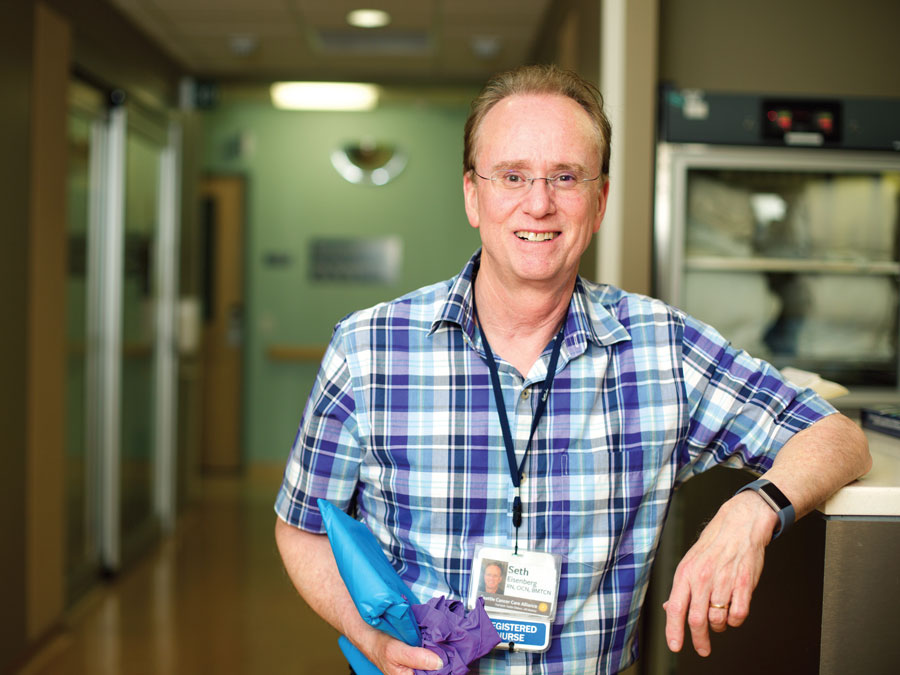Police officers wear body armor and construction workers wear hard hats. Why? Because these professions carry inherent dangers in the line of duty—And oncology nursing does too.
Statistically, healthcare workers face more workplace-related dangers than both law enforcement and construction, yet attention to safety and personal protection isn’t always a central focus. This can be especially true in cancer care, where nurses are required to administer hazardous drugs (HDs) and handle dangerous medications on a daily basis. Although safety recommendations exist, few enforceable standards are protecting nurses handling HDs.
To address the gap in practice, the U.S. Pharmacopeial Convention (USP) developed a new chapter in its guidelines for compounding standards related to safe handling of HDs. With USP chapter <800>, institutions are required to update their policies and procedures to ensure safety among all healthcare staff who encounter HDs. According to USP <800>, all HDs must be handled under conditions that promote patient safety, worker safety, and environmental protection. As the main point of care for patients receiving HDs like chemotherapy, oncology nurses are directly involved with implementation of USP <800> in practice.
Understanding USP <800>
Guidelines for safe handling have existed for years, yet dedicated safe-handling standards that were enforceable on a state level were still needed. According to ONS member Seth Eisenberg, RN, ADN, OCN®, BMTCN®, professional practice coordinator of infusion services at Seattle Cancer Care Alliance in Washington, USP’s new chapter addresses the issue.

“USP is a pharmacy-centric, nonprofit organization that sets standards for quality and purity of medications. They issue national formulary chapters; those numbered less than 1000 are considered standards, and those above 1000 are guidelines,” Eisenberg says. “Although chapter <797> (sterile compounding) had a couple of paragraphs regarding HD safety, considerably more information and standards were necessary, thus earning its own chapter.”
The road to implementation has been long for USP <800>. ONS member AnnMarie Walton, PhD, MPH, RN, OCN®, CHES, assistant professor in the School of Nursing at Duke University in Durham, NC, has been actively following its trajectory since its inception.

“Chapter <800> came out first in 2014 and has undergone several rounds of public comment and revisions,” Walton says. “It currently has an implementation deadline of December 1, 2019. But it’s important to remember that many of the practice standards included in the chapter are not new. The chapter was developed with existing information from the National Institute for Occupational Safety and Health (NIOSH), ONS, and the American Society of Health System Pharmacists (ASHP), among many others.”
Although many details from USP <800> will be familiar to nurses, Eisenberg outlines new standards based on current evidence to promote safety and reduce occupational risks.
“Most of what is included in the chapter should be familiar to oncology nurses because it mimics the current NIOSH and ONS guidelines,” Eisenberg says. “However, it has some pertinent differences. For example, USP <800> requires double gloving with two pairs of gloves meeting the ASTM 6978-05 (or its successor) standard. Not all gloves are created equal, and simply putting the word ‘chemotherapy’ on the box does not make gloves safe for HDs.”
Walton and Eisenberg both cite other new requirements from USP <800>, including acknowledging the risks for all staff handling HDs, the use of closed-system transfer devices (CSTDs) for antineoplastic agents at the point of administration, and the aspects that relate to compounding (see sidebar on p. 18). Practice settings vary in terms of what role nurses play in HD compounding, but it does involve mixing HD drugs, including crushing pills and administering via feeding tubes in oncology and non-oncology settings (e.g., home care, skilled nursing facilities).
The Dangers of Hazardous Drug Exposure
Part of USP <800> requirements include acknowledging the dangers associated with handling HDs and ensuring that providers are aware of them. Exposure to cytotoxic agents used in cancer treatments can have serious effects on providers’ health, including carcinogenicity, fertility, and pregnancy.
“Exposure typically occurs via the dermal route. Nurses can become exposed during any one of several activities, including preparation, manipulation of oral agents (e.g., crushing pills at the bedside), administration (including IV, subcutaneous, and procedural routes), during spill cleanup, and from excreta containing HDs,” Eisenberg says. “Some HDs can vaporize at room temperature, making inhalation during spills a concern. This is why so many of our safety mechanisms are designed to prevent or minimize exposure via these routes.”
Walton lists the litany of potential problems providers may face after exposure to HDs in practice.
“It can cause acute problems like skin rashes, nausea, vomiting, and hair loss. There’s also a host of reproductive problems associated with exposure, including spontaneous abortion and adverse reproductive outcomes,” Walton says. “Exposure also increases risk for some cancers. Oncology nurses have the potential for long-term, low-dose exposure to multiple drugs. It can happen when they’re administering them, disposing them, or even handling bodily fluids of patients receiving them.”
Because of the potential effects of HDs on fertility and pregnancy, ONS recommendations suggest workers at risk for exposure to HDs should be offered alternative duty if they are trying to conceive or are pregnant or breast feeding.
For the safety of healthcare providers and the patients and families they serve, both Walton and Eisenberg emphasize the importance of USP <800>—and the way it could improve practice quality and safety for everyone.
Implications for Nursing Practice
Eisenberg says he’s glad that USP <800> is signaling an attitude change for safe handling.
“Perhaps the biggest—and most important—aspect of USP <800> is that unlike the current NIOSH, ONS, and ASHP guidelines, this chapter is a standard and many aspects will be enforced. Organizations must comply with the standards or face consequences,” Eisenberg says. “USP has the support of major players in health care, and enforcement will be via one or more of the following agencies: state boards of pharmacy, U.S. Food and Drug Administration, Centers for Medicare and Medicaid Services, and Joint Commission. Failure to comply can result in loss of Medicare funding, accreditation status, and potentially pharmacy licensure. This is the greatest strength of USP <800>: we’ve had good guidelines for decades, but they were never enforced until now.”
Walton says that nurses, at their core, stand at the front lines of safety and quality in practice. They spend the most time with patients and administer the most cancer treatments of any provider, putting them at risk for hazardous effects. Safe handling standards such as USP <800> protect nurses, patients, and families and promote workplace safety, and nurses are in a position to lead change.
“Nurses need to realize that we are leaders when it comes to quality and safety—it’s a huge part of our role. Patients and family members look to us for education and information about safe handling in the home environment, and other members of the healthcare team ask us and expect us to model best safe-handling practices,” Walton says. “We can do a lot on our units to ensure that USP <800> is followed, including using proper personal protective equipment, communicating hazards, ensuring education takes place, and routinely reviewing safety protocols. But nurses can take that one step further by joining facility-wide teams to address safety issues at a higher level, bringing their expertise in quality and safety to those tables as well.”
Overcoming Challenges
Implementing USP <800> isn’t easy, and Walton says that some institutions are facing high costs.
“Many facilities have been preparing for USP <800> for some time now,” Walton says. “But the requirements can be extensive and expensive. For instance, using CSTDs at the point of administration is not current practice in every institution, and it can require a significant investment to implement the devices. Beyond the cost, institutions have questions about which CSTD to use, how to get it into the institution, how to get training on it, and ways to ensure practice change.”
Some institutions’ older architecture may lead to significant challenges in meeting USP <800> requirements that all pharmacies compounding HDs must be externally ventilated, Eisenberg says. However, some healthcare providers are still clinging to unsafe habits from the past.
“Older hospitals with pharmacies in their basements will have to overcome ventilatory obstacles. Private practices and some community hospitals will also have difficulties complying with the compounding requirements,” Eisenberg says. “Healthcare administrators who have resisted the previous guidelines because of the inherent cost of personal protective equipment, CSTDs, and other engineering controls will have to understand that HD safety is no longer an option; it is the cost of providing cancer care, just as safety equipment is required for construction workers and other industries.”
Driving a Culture of Safety
Eisenberg says that implementation of USP <800> can lead to huge downstream effects for provider safety and well-being.
“The chapter has the greatest potential for affecting HD safety since the 2004 NIOSH alert,” he says. “Although it’s far from perfect—and is conspicuously pharmacy-centric in its content—they are the first required HD standards in the United States, and it will help ensure healthcare worker safety.”
Nurses can advocate for policies that protect healthcare workers from HDs’ reproductive risks and wear personal protective equipment at all times: gown, double gloves, mask, and eye protection, with disposable gown changes between patients.
And Walton knows that best practices for safety extend beyond the realms of nursing.
“It’s really important that everyone on the medical team understands the importance and impact of safe handling,” she says. “Contamination in the work environment affects everyone—patients, family members, administrative workers, and even the public who visit the unit—so everyone has a role to play in the safety of our workplaces and healthcare institutions.”
USP <800>’s enforceability will be decided and regulated at the state level. To support the health and safety of all providers who handle HDs, ONS and organizations such as the Hematology/Oncology Pharmacy Organization advocate for full enforcement of USP <800> through position statements and other resources.






